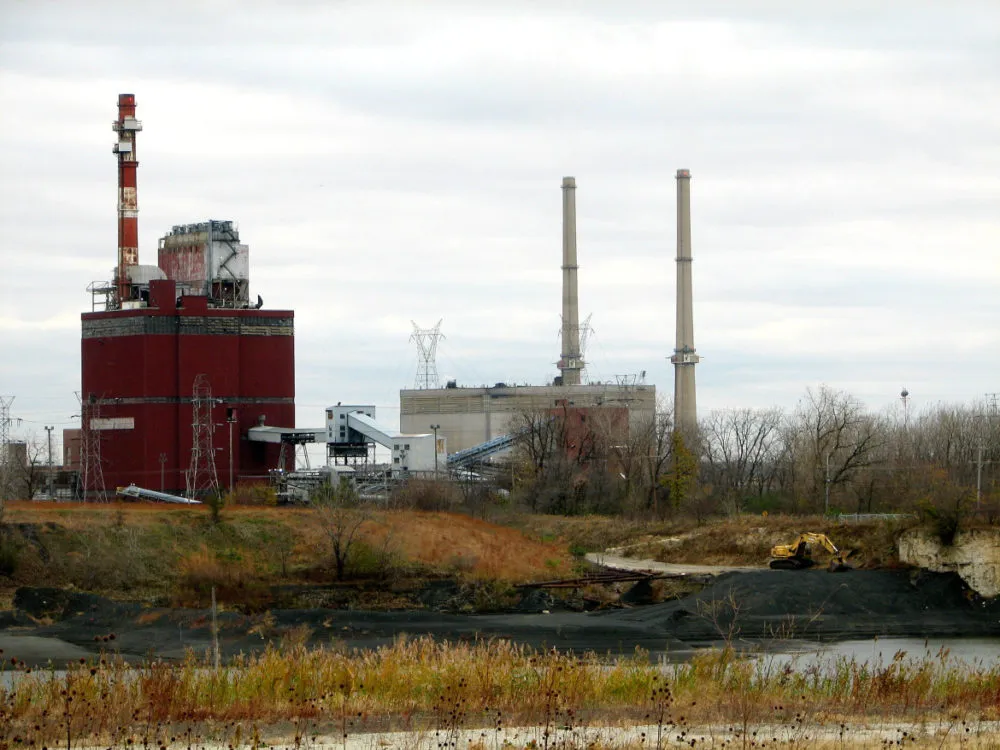
By Kari Lydersen, Energy News Network
This story was first published on the Energy News Network and was republished here with permission.
A recent state procurement formalizes plans to put solar and storage on the site of several retired coal plants. The owners will receive grants and higher-value renewable energy credits to finance the projects.
Solar panels and energy storage will be paired on the sites of six retired coal plants in downstate Illinois under a provision of last fall’s sweeping state energy law.
The sites for the installations were recently announced, along with five other former coal plants that will host standalone energy storage projects. Vistra, which owns the solar-plus-storage sites, will receive a premium for renewable energy credits at those locations, while the state will provide grants to the battery-only projects, owned by Vistra and NRG Energy.
The companies and other proponents hailed the program as a pioneering model, helping to create jobs, bolster the tax base and generate clean energy in communities where coal plants have closed. Vistra spokesperson Meranda Cohn called it “a first-in-the-nation fleet transformation of legacy coal plants into renewable energy centers.”
Vistra has said the projects, slated to break ground next spring, will create 60 to 100 direct, indirect and induced jobs at each plant. Property tax revenue is expected to double at many of the sites, according to the company. The state energy law says construction jobs must pay prevailing wage, companies must negotiate labor agreements, and 25% of contractors must meet diversity criteria.
“Any community that’s facing a major economic facilities closure — whether it’s a coal plant or manufacturing facility — there’s a property tax loss, an economic loss, the workers aren’t going to lunch, the sales tax isn’t there,” said Katie Stonewater, senior advisor on energy and broadband at the Department of Commerce and Economic Opportunity. “This program is one way to support those communities via helping to replace those property tax revenues. And there are other economic benefits — well-paying construction jobs, workers patronizing local businesses. It helps lessen the broader economic burden” of a plant closing.
Vistra will put between 20 and 68 megawatts of solar and 6 to 9 MW of storage at six of its coal plant sites throughout downstate Illinois, and it will put 37 MW of standalone storage at three other downstate Illinois plants. NRG will build 72 MW of storage each at its Waukegan plant north of Chicago, where it recently closed coal-fired units, and its Will County plant in the southwest Chicago suburbs.
The state Department of Commerce and Economic Opportunity described the storage grants as a competitive process, though the law was written to make clear which sites would qualify. Vistra announced its site-specific plans when the Climate and Equitable Jobs Act passed last fall.
The power companies had reportedly pushed hard for the coal-to-solar provisions in the law, which mandates all fossil fuel generation cease by 2045. Some experts noted that while there’s little drawback to the project, it seems largely symbolic since the amount of solar being constructed — just over 200 MW across six sites — is a drop in the bucket in terms of the thousands of megawatts needed to meet the state’s goal of 100% clean power by 2050. Meanwhile, there might be better places to locate energy storage than the rural, remote sites of several of the coal plants.
‘A fair and justified’ subsidy
Vistra and NRG will receive $79.2 million and $40.7 million respectively for each of the 72- and 37-MW storage sites over 10 years, a total investment of $280.5 million from the state.
An April procurement by the Illinois Power Agency means Vistra will get renewable energy credits — equivalent to a megawatt-hour of power — that it can sell for $30 each for 20 years, for a total cost of about $14 million a year. That’s more expensive than utility-scale solar that the power agency typically procures. In 2018, renewable energy credits for utility-scale solar were pegged at $4.64
in a competitive bidding process. Currently utility-scale solar is procured in a different way that makes it hard to compare prices, but experts said it is still significantly cheaper than the credits being issued for the coal-to-solar program.
“These prices are above market; this was a compromise part of the legislation,” said Jack Darin, director of the Sierra Club’s Illinois chapter. “But there was a lot of support for doing something at these facilities. We want to see investments made at communities that were dependent on coal plants.”
The credit prices offered through the coal-to-solar program aren’t without precedent: In 2019, the power agency set a price of $58.10 per renewable credit for solar developed on brownfields.
The state Adjustable Block Program that incentivizes distributed and community solar in 2021 saw credit prices
of $37 to $98, depending on the size, type of project and whether contractors met equity criteria.
J.C. Kibbey, Illinois clean energy advocate for the Natural Resources Defense Council, said he sees “a fair and justified role now for the subsidy” in the coal-to-solar program.
“Hybrid solar-plus-storage projects are relatively new but growing very rapidly,” Kibbey said. “The amount of storage deployed in the U.S. in 2021 was double what it was in 2020. A handful of states have already created incentives for storage, and Illinois can look at those different approaches and learn from them as we figure out how we want to support storage here.”
The Illinois Power Agency will hold another procurement in the fall for solar and storage on coal sites north of Interstate 80, with NRG’s Powerton plant in the PJM market eligible. That procurement will offer the right to sell renewable energy credits at $30 for 15 years.
Solar capacity
Kibbey noted that solar at the Vistra plants in downstate Illinois can bid into grid operator MISO’s capacity markets with a 50% capacity credit — meaning half of their nameplate megawatts. Battery storage has a 95% capacity credit, and while it’s not yet clear how exactly solar plus storage will be credited, they likely will receive significant capacity credit, as the Great Plains Institute explains.
“The energy and capacity from these projects is really important particularly right now and particularly because solar is paired with storage, since there are issues with resource adequacy in the MISO zone that have driven up prices,” Kibbey said. “Solar projects that are paired with storage will almost certainly receive higher capacity values from MISO.”
He said that putting solar and storage on coal plant sites is a much cleaner option than replacing coal-fired plants with natural gas-fired peaker plants, as companies often do.
“As coal plants are coming offline, if we’re serious about avoiding catastrophic climate change, we need to replace them with solar plus storage, energy efficiency, demand response, and other clean resources — not gas plants,” Kibbey said.
Standalone storage
When the Climate and Equitable Jobs Act was being debated, some residents were disappointed that companies didn’t plan to put solar on coal plant sites in their communities. NRG spokesperson Dave Schrader said NRG does not plan to add solar at the Waukegan or Will County sites.
“Many factors need to be considered when choosing solar and/or storage projects at any location,” he said. “They include land availability, access to transmission, cost of construction, and energy prices. Battery storage and renewable power like solar do not need to be co-located for them to work as designed. Geographic diversity actually serves to increase the reliability of these projects — just like not having all of your eggs in one basket.”
He said the Waukegan and Will County storage sites would be “the first utility-scale energy storage projects owned and operated by NRG.”
“NRG expects to enter into project labor agreements for the construction of the battery energy storage projects, including efforts to improve diversity at our job sites and creating apprenticeship and training opportunities for current and former coal-fired power plant workers,” Schrader added.
Cohn noted Vistra operates “the world’s largest battery energy storage facility,” at a natural gas-fueled power plant in California. Once an expansion is complete, it will store up to 750 MW of power. The company also runs Texas’ biggest energy storage site, the 260-megawatt DeCordova Energy Storage Facility next to a natural gas plant.
In Illinois, “the storage-only program ensured every impacted plant site could participate and no community would be left behind,” Cohn said. “These storage resources are needed to help balance the intermittency of renewable generation. Battery energy storage facilities provide grid-wide benefits, whether co-located next to generation or placed at strategic locations, to take and store energy during low-demand, high-production periods and then provide/release the stored electricity to the grid during periods of high demand.”
Storage needs to be built along with solar on coal plant sites to get the right to sell solar renewable energy credits through the coal-to-solar program, though there are no credits specifically for energy storage.
Illinois Power Agency Director Anthony Star said entities such as the platform M-RETS are studying how to better incentivize energy storage, and a model like renewable energy credits could potentially be used in the future — though not necessarily in the coal-to-solar program.
“Determining the right incentive structure in the long-term for storage remains an open policy issue,” Star said. “Currently RECs are generated by renewable energy projects based on their monthly output. In the future, changes to the structure of REC markets could allow for RECs to be more granular and recognize when the energy is supplied to the grid. In that way, storage projects that deliver energy when it is most needed could be compensated accordingly.”
Real just transition
Darin said that while the coal-to-solar projects are important, a real transition to clean energy won’t be made unless the companies fully clean up coal ash that is stored at the sites, largely in unlined pits that have contaminated groundwater, according to monitoring the companies are required to do.
“We are pleased these sites are headed to productive reuse, but it’s important they be adequately remediated, which in most cases means the coal ash is completely removed,” Darin said. “To be beneficial community assets also has to mean they’re not polluting the water supply.”
Community members in Waukegan, where NRG will put 72 megawatts of storage, have long demanded a robust just transition plan from the company, and they are angry the company plans to leave coal ash in place at the lakefront site.
“Waukegan is eager to move forward with green lakefront uses, that should be compatible [with energy storage] if done right,” Darin said. “We really have the potential to turn these sites from fenced-off sources of pollution to real community assets.”
Catch more news on Great Lakes Now:
Can shipping on the Great Lakes take the next step toward transporting high-value container cargo?
Industries and public water supplies top list of main consumers of Great Lakes water




